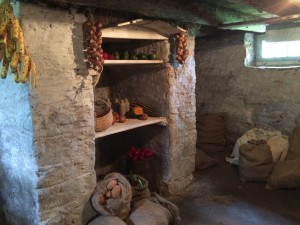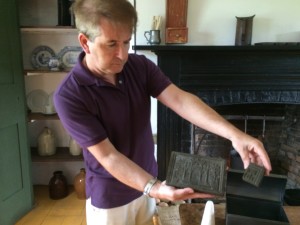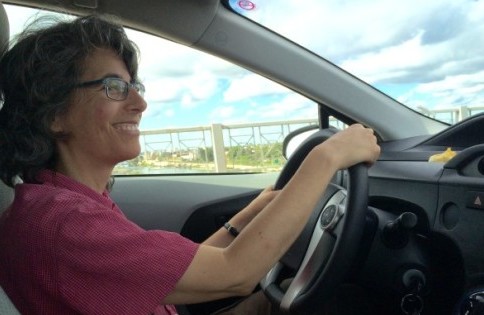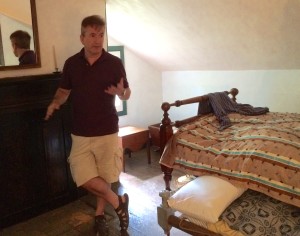As a student, Daryl MacTavish hated history. It seemed like a collection of irrelevant and isolated facts. Somehow, however, a summer job turned into a career of sparking people’s interest in history, through the stories of old homes and the lives of the people who lived in them.
I met Daryl on my Educational Road Trip to study slavery and the Underground Railroad.
Daryl wears many hats at the Fieldcote Memorial Park and Museum; he took us on a tour of the Griffin House, a small farm house from the 1830’s in Ancaster, Ontario.
The Griffin House was not on our list – but when you are driving 2,000 miles from Cincinnati to New York City anyway, why not stop at a place on the map that someone told you was worth visiting?
 The house and artifacts were interesting, but I have to admit that after two weeks of touring museums and historical sites, I was over the novelty of rope beds, chamber pots, cooking stoves and shards of broken teacups.
The house and artifacts were interesting, but I have to admit that after two weeks of touring museums and historical sites, I was over the novelty of rope beds, chamber pots, cooking stoves and shards of broken teacups.
But I, who was deeply engaged as a student of history, learned more about 19th century farm life in two hours than I learned in all of my schooling, independent reading, and watching episodes of Little House on the Prairie.
So how did he do it? Through story.
As he walked us through the house, he pointed to things and began telling stories. Sometimes they were stories about the people who lived there, but often they were things like this.
19th Century Rope Beds
When we went to an upstairs bedroom, Daryl asked “Why do you think the beds were so small?” It wasn’t because people were shorter, it was because people believed they should not sleep lying down completely, and especially not on their backs. It felt like lying dead in their caskets. Most people slept almost sitting up, so the beds didn’t need to be bigger.
Then he explained the night time ritual:
On a farm, people typically slept on beds with mattresses made of straw. The body’s weight and moisture would begin to flatten the straw and create hills and valleys in the bed. There were no box springs to support the straw mattress, but there were crisscrossed ropes holding it up, which people tightened each night with a special tool.
And, since the straw came from the barn, it was good to give it a pounding to scare away any insects that might still be inside. From these bedtime rituals came expressions like “sleep tight” (tighten the ropes), “hit the hay,” and “don’t let the bed bugs bite.”
Strong Farm Women
In the kitchen, Daryl pulled out a steel box and asked us to guess its contents. I couldn’t even begin to come close. Then he took out a white cone shaped object and a sort of stinky black one. What were they?
Well, I guessed that cone was sugar (only because I had seen something similar on display at an earlier museum). White sugar was pressed into cones and little pieces were broken off as needed.
 White sugar was expensive so most people used sweeteners like honey, maple syrup, molasses and brown sugar (derived from boiling molasses). Funny that today white sugar is a cheap commodity and those other sweeteners are so much more expensive (and healthier).
White sugar was expensive so most people used sweeteners like honey, maple syrup, molasses and brown sugar (derived from boiling molasses). Funny that today white sugar is a cheap commodity and those other sweeteners are so much more expensive (and healthier).
The stinky thing looked like a metal waffle. It had a familiar smell. But I had no idea that it was tea! Tea leaves were pressed into a mold and like the sugar broken off as needed. Sugar and tea were stored in metal boxes to keep the mice out.
He took out another box and let us try to start a fire with flint. There was a metal ring that you placed around your hand (sort of like a brass knuckle); you’re supposed hit it with the flint stone until you create a big enough spark to light the kindling. I hardly got a spark, but I sure hit my knuckle hard. Ouch!
Did I succeed? Watch me try here:
Then he talked about farm women, who, he said, worked as hard as men and were often almost as strong. Lifting heavy iron pots over fires and churning butter gave them great upper body strength.
In addition to their strength, they also need to be smart. They did all sorts of kitchen calculations. When cooking over an open stove, there is no dial to adjust the temperature. Back in the day, recipes called for long and short hooks (closer and further from the fire) and quick and slow fires and a lot of good judgment. Preserving food also relied heavily on math.
Other People’s Trash
Even those broken teacups that I mentioned earlier became more interesting through Daryl. He said that artifacts were found in the yard around the house. I said that I had heard that a lot. Why did old homes have so much stuff in the yard? My yard has only weeds.
Well, duh, I have garbage collection.
Back then, when someone broke something, they often buried it outside as a way to dispose of it – especially if they didn’t want someone to know it had been broken. In fact, the need to dispose of broken items – that couldn’t be repurposed or reused – was so customary that people began to have a designated place in the yard, sort of like a compost heap, to bury things.
For historian or archeologist, there’s deep truth in the expression “One person’s trash becomes another’s treasure.” When someone comes to excavate a historical site, one of the first things they do is to try to figure out where the middin (old farm trash heap) was, because it would likely be a trove of artifacts (albeit broken ones – which explains why I’ve seen so many broken teacups).
The second place that excavators look? “They try to locate the outhouse site.” What? Yes, because things slip out of pockets and into the ground. Which lead to a whole discussion about other names for outhouse: “privy” and “necessary.”
This is where Daryl revealed his formula for keeping kids engaged on a historical tour- provide a funny fact, then a general fact. Follow up with a gross fact then a historical fact: Do a demonstration, then add a mundane fact.
Of course, his facts were embedded in story, they weren’t mere recitations. His formula made me laugh, but it also made me see that he had figured out a way to engage people, especially kids, and make history feel real and personal.
Want to read more about my Educational Road Trop to study slavery and the Underground Railroad? Find links to all posts on my Fund For Teachers page, or click on the links below.
***
Links to all Underground Railroad blog posts:



Leave A Response